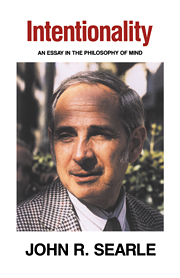Book contents
- Frontmatter
- Contents
- Acknowledgements
- Introduction
- 1 The nature of Intentional states
- 2 The Intentionality of perception
- 3 Intention and action
- 4 Intentional causation
- 5 The Background
- 6 Meaning
- 7 Intensional reports of Intentional states and speech acts
- 8 Are meanings in the head?
- 9 Proper names and Intentionality
- 10 Epilogue: Intentionality and the brain
- Subject index
- Name index
2 - The Intentionality of perception
Published online by Cambridge University Press: 05 June 2012
- Frontmatter
- Contents
- Acknowledgements
- Introduction
- 1 The nature of Intentional states
- 2 The Intentionality of perception
- 3 Intention and action
- 4 Intentional causation
- 5 The Background
- 6 Meaning
- 7 Intensional reports of Intentional states and speech acts
- 8 Are meanings in the head?
- 9 Proper names and Intentionality
- 10 Epilogue: Intentionality and the brain
- Subject index
- Name index
Summary
Traditionally the “problem of perception” has been the problem of how our internal perceptual experiences are related to the external world. I believe we ought to be very suspicious of this way of formulating the problem, since the spatial metaphor for internal and external, or inner and outer, resists any clear interpretation. If my body including all of its internal parts is part of the external world, as it surely is, then where is the internal world supposed to be? In what space is it internal relative to the external world? In what sense exactly are my perceptual experiences ‘in here’ and the world ‘out there’? Nonetheless these metaphors are persistent and perhaps even inevitable, and for that reason they reveal certain underlying assumptions we will need to explore.
My aim in this chapter is not, except incidentally, to discuss the traditional problem of perception, but rather to place an account of perceptual experiences within the context of the theory of Intentionality that was outlined in the last chapter. Like most philosophers who talk about perception, I will give examples mostly concerning vision, though the account, if correct, should be general in its application.
When I stand and look at a car, let us say a yellow station wagon, in broad daylight, at point blank range, with no visual impediments, I see the car. How does the seeing work? Well, there is a long story about how it works in physical optics and in neurophysiology, but that is not what I mean.
- Type
- Chapter
- Information
- IntentionalityAn Essay in the Philosophy of Mind, pp. 37 - 78Publisher: Cambridge University PressPrint publication year: 1983
- 3
- Cited by



